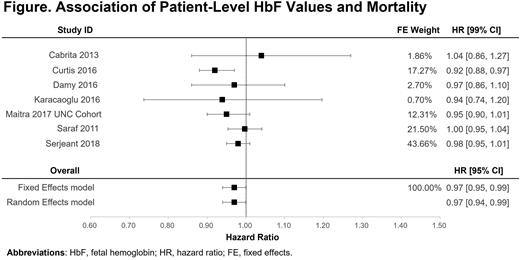Abstract
Background: Sickle cell disease (SCD) significantly reduces a patient's lifespan by decades when compared to the general population. Death may be caused by acute events (e.g., infection, stroke) or accumulated damage from chronic organ failure (e.g., renal failure, heart failure). Individual studies have confirmed HbF (fetal hemoglobin) protects against pathophysiological events that contribute to the life-threatening acute events and chronic organ damage associated with SCD. However, the totality of evidence describing the relationship between HbF and mortality has not been systematically explored to date. We aim to assess and describe the protective effects of elevated HbF levels on mortality among patients with SCD.
Methods: A systematic literature review (SLR) was performed in Embase, MEDLINE, and the Cochrane Library to identify all evidence describing HbF levels and/or longitudinal changes versus mortality among patients with SCD. Observational and interventional studies published between 1980-2021 were considered for inclusion. Citations were screened and extracted by dual independent review. The inverse variance method was used to pool individual study hazard ratios (HR) to estimate HbF protection (including 95% confidence interval [CI]) against mortality. Variability in study design, outcomes analyses, reporting methods, and other factors contributed to the heterogeneity of results.
Results: The SLR identified 2997 citations, from which 37 studies describing 87 distinct data points related to mortality were selected for investigation. These 37 studies described the relationship between HbF and mortality in 4 different ways:
1. Eleven studies reported 16 distinct analyses quantifying the relationship between patient-level HbF values versus mortality rates (as hazard, odds, risk, or correlation). HbF demonstrated a protective effect in 14 of the 16 analyses. Notably, 1 meta-analysis of 8 hazard ratios was identified. This meta-analysis demonstrated that HbF was significantly protective against mortality, reporting that a 1% unit increase in HbF decreased mortality risk by 3% (HR=0.97; 95% CI=0.94-1.00) (Figure). We updated and refined this meta-analysis to include more recently published studies and to exclude any cohorts in which all patients received hydroxyurea (HU) to reduce this confounding variable. HR values from 7 individual studies were pooled in the updated and refined analysis. The results were significant and demonstrated that a 1% unit increase in HbF lowered mortality risk by 3% (HR=0.97; 95% CI=0.95-0.99), consistent with the original meta-analysis and further supporting the importance of HbF elevation in reducing SCD-related mortality.
2. Three studies assessed HbF levels in patients who survived versus died during the study period. All 3 studies reported significantly higher HbF levels in patients who survived. The mean differences in HbF in the 3 studies between patients who survived versus those who died during the study period were 2.9%, 3.0% and 6.2%.
3. Two studies assessed mortality rates based on different HbF levels; both showed that mortality was lower in patients with higher HbF levels. In the first study, there were 50 deaths per 1000 patient-years (PY) in patients with HbF ≤ 2% versus 11.1 deaths per 1000 PY in patients with HbF > 2% (P < 0.05). In the second study, there were 7.8 deaths per 1000 PY in patients with HbF ≤ 8% versus 7.6 deaths per 1000 PY in patients with HbF > 13% (not significant).
4. Finally, average mortality rates based on study-level HbF averages were investigated for 47 cohorts. A trend was observed for higher HbF levels associated with lower mortality rates, but this was not statistically significant when assessed using weighted linear regression.
Conclusion: The totality of evidence suggests that HbF reduces mortality risk in SCD. Furthermore, robust analyses indicate that relatively small increases in HbF provide meaningful reductions in mortality risk.
Disclosures
Allen:Fulcrum Therapeutics: Current equity holder in publicly-traded company.
Author notes
Asterisk with author names denotes non-ASH members.


